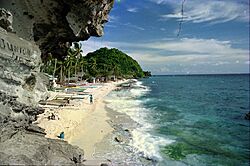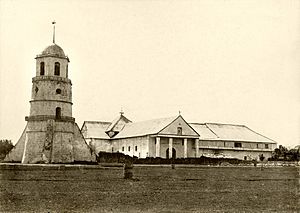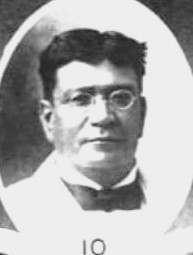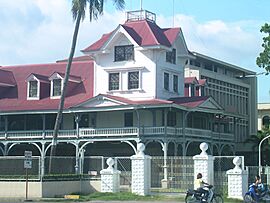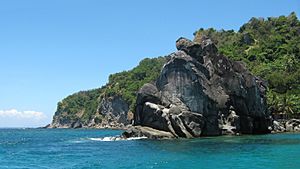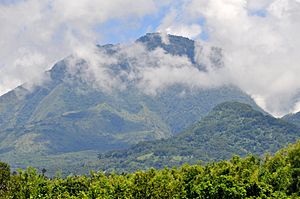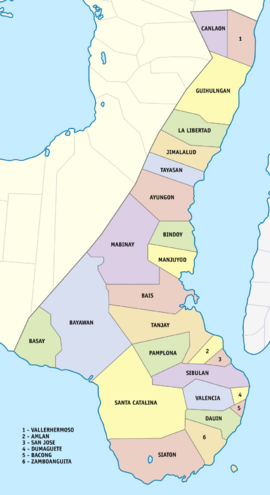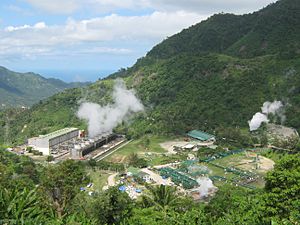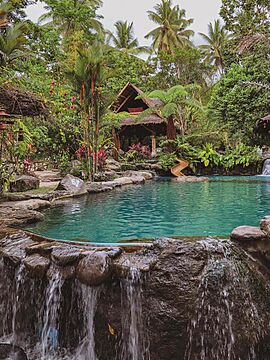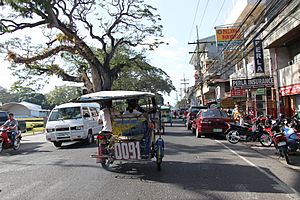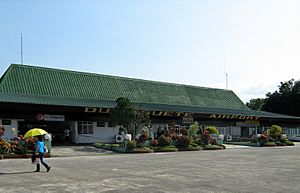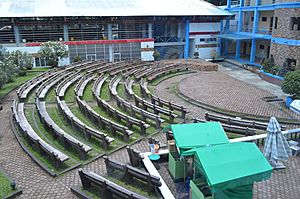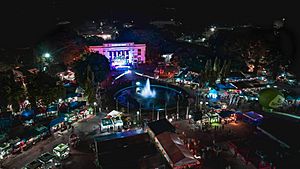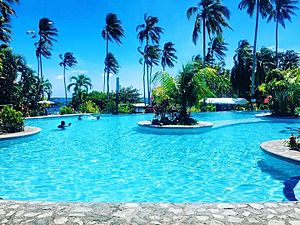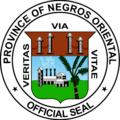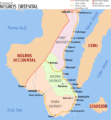Negros Oriental facts for kids
Quick facts for kids
Negros Oriental
Sidlakang Negros
|
|||
|---|---|---|---|
|
(from top: left to right) Apo Island, Silliman University, Lake Balinsasayao, Negros Oriental Provincial Capitol in Dumaguete, and Lake Balanan
|
|||
|
|||
| Motto(s):
Veritas Via Vitae
("The truth is the way of life") |
|||
| Anthem: Garbo sa Kabisay-an (literally: Pride of the Visayas) |
|||

Location in the Philippines
|
|||
|
OpenStreetMap
|
|||
| Country | Philippines | ||
| Region | Negros Island Region | ||
| Founded | January 1, 1890 | ||
| Capital and largest city |
Dumaguete | ||
| Government | |||
| • Type | Sangguniang Panlalawigan | ||
| Area | |||
| • Total | 5,385.53 km2 (2,079.36 sq mi) | ||
| Area rank | 17th out of 81 | ||
| Highest elevation | 2,465 m (8,087 ft) | ||
| Population
(2020 census)
|
|||
| • Total | 1,432,990 | ||
| • Rank | 19th out of 81 | ||
| • Density | 266.0815/km2 (689.1480/sq mi) | ||
| • Density rank | 35th out of 81 | ||
| Divisions | |||
| • Independent cities | 0 | ||
| • Component cities |
6
Bais
Bayawan Canlaon Dumaguete Guihulngan Tanjay |
||
| • Municipalities |
19
Amlan
Ayungon Bacong Basay Bindoy Dauin Jimalalud La Libertad Mabinay Manjuyod Pamplona San Jose Santa Catalina Siaton Sibulan Tayasan Valencia Vallehermoso Zamboanguita |
||
| • Barangays | 557 | ||
| • Districts | Legislative districts of Negros Oriental | ||
| Time zone | UTC+8 (PST) | ||
| IDD : area code | +63 (0)35 | ||
| ISO 3166 code | PH-NER | ||
| Spoken languages | |||
| Highway routes | |||
| Income classification | 1st class | ||
| Website | www |
||
Negros Oriental (also called Sidlakang Negros in Cebuano) is a province in the Philippines. It is located on the southeastern part of the large Negros Island. Its capital city is Dumaguete, which is also one of the main centers of the Negros Island Region.
Negros Oriental shares a border with Negros Occidental to the northwest. It also faces Cebu across the Tañon Strait and Siquijor to the southeast. A famous spot here is Apo Island, known for its amazing dive sites. The main language spoken is Cebuano, and most people are Roman Catholic. In 2020, the province had about 1.4 million people. This makes it the second most populated province in the region.
History of Negros Oriental
Early Beginnings of Negros Island
The island of Negros is the largest island in the Visayas group. It is thought that Negros was once part of a bigger landmass. This landmass was separated by rising waters after the last ice age. The first people to live on the island were the Negritos and later the Austronesians. Chinese merchants also visited the island. They called the island "Buglas," which means "cut off" in their native language.
Spanish Rule and Division of the Island
Spanish explorers, led by Miguel Lopez de Legazpi, first arrived in April 1565. They landed on the western side of the island. They saw many dark-skinned people and named the island "Negros," which means "black" in Spanish. At first, the island was not very populated.
In 1571, the Spanish started to settle the island. Augustinian priests began teaching Christianity the next year. For a long time, Negros was managed from Oton. In 1734, it became a military district, with Ilog as its capital. Later, the capital moved to Himamaylan in 1795, and then to Bacolod in 1865.
Because of attacks from Moro pirates, especially in the southeastern parts, people wanted the island to be divided. On January 1, 1890, the island of Negros was split into two provinces: Negros Oriental and Negros Occidental. Dumaguete became the first capital of Negros Oriental. In 1892, Siquijor also became part of Negros Oriental.
The Philippine Revolution reached Negros in 1898. The Spanish government in Dumaguete was overthrown on November 24, 1898. Later, the two Negros provinces joined to form the Cantonal Republic of Negros.
American Period and World War II
In 1901, the United States took control, and a civil government was set up. Demetrio Larena became the first governor. Siquijor was made a "sub-province" of Negros Oriental. Roads and bridges were built during this time.
During World War II, Japanese forces invaded both Negros provinces. Many people fled to the mountains. Philippine and American soldiers, along with local fighters, freed Negros Island on August 6, 1945.
Recent History and Regional Changes
On September 17, 1971, Siquijor became its own independent province.
The town of Guihulngan became a city on June 14, 2007. Its city status was challenged twice but was finally confirmed by the Supreme Court on February 15, 2011.
On May 29, 2015, the Negros Island Region was created. Negros Oriental moved from the Central Visayas region to this new region. However, on August 9, 2017, the Negros Island Region was dissolved due to a lack of funds. This meant Negros Oriental returned to the Central Visayas region.
In 2018, there were talks about reuniting Negros Oriental and Negros Occidental into one federal region. Some people suggested renaming the provinces to "Buglas Sidlakan" and "Buglas Nakatundan" to remove the negative meaning of "Negros."
As of June 13, 2024, Negros Oriental was again transferred to the Negros Island Region. This happened when President Bongbong Marcos signed Republic Act 12000.
Capitol Building's 100th Anniversary
On May 17, 2024, the Negros Oriental Capitol building celebrated its 100th anniversary. A historical marker was placed by the National Historical Commission of the Philippines. Many important people attended the event, which included performances and a fireworks show.
Geography and Landscape
Negros Oriental covers the southeastern part of Negros Island. It has a total land area of about 5,385.53 square kilometers. A range of rugged mountains separates it from Negros Occidental. To the east, it faces Cebu across the Tañon Strait, and Siquijor to the southeast. The Sulu Sea is to its south and southwest.
Negros Island is mostly volcanic, which means its soil is very good for farming. About 80% of the usable land on the island is farmed.
Mountains and Natural Features
The province has low, hilly mountain ranges, some of which are near the coast. In the south, you'll find Mount Talinis, also called Cuernos de Negros ("Horns of Negros"). This is a dormant volcano that rises to 2,000 meters. In the north, there is the active Kanlaon Volcano, the highest peak on the island at 2,465 meters. There are also some flat areas and plateaus in the southwest, like the Tablas Plateau.
A famous landmark in Dumaguete is the Dumaguete Bell Tower. It stands next to the Saint Catherine of Alexandria Cathedral. Long ago, it was used to warn the city about incoming pirate attacks.
Weather Patterns
Negros Oriental has a tropical climate. Because of the mountain range running through the island, the province has two different weather types. The eastern part has a clear wet season and a short dry season (1-3 months). The western part has distinct wet and dry seasons.
Cities and Towns
Negros Oriental is made up of 19 municipalities and 6 cities. These are further divided into 557 smaller areas called barangays.
Dumaguete is the capital city and the center of government. It is also the most populated city in the province, even though it has the smallest land area.
For political representation, the cities and municipalities are grouped into three congressional districts. Each district elects a congressman to the House of Representatives of the Philippines.
Population and Languages
| Languages Spoken (2000) | ||||
|---|---|---|---|---|
| Language | Speakers | |||
| Cebuano | 1,427,065 | |||
| Hiligaynon | 165,308 | |||
| Other Visayan languages | 39,174 | |||
| Boholano | 4,147 | |||
| Others | 8,318 | |||
| Not Reported | 8,065 | |||
In 2020, Negros Oriental had a population of 1,432,990 people. This means there were about 250 people per square kilometer. About 34.5% of the population lives in the six largest cities: Dumaguete, Bayawan, Guihulngan, Tanjay, Bais, and Canlaon. The population grew by about 0.99% each year between 2010 and 2015.
People from the whole Negros island are often called "Negrenses." Those from Negros Oriental sometimes call themselves "NegOrenses" to show they are from this specific province. Most NegOrenses have Austronesian roots.
Languages Spoken in Negros Oriental
Negros Oriental is mostly a Cebuano-speaking province. This is because it is very close to Cebu. About 72% of residents speak Cebuano as their first language. Hiligaynon is spoken by the other 28%, especially near the border with Negros Occidental.
Filipino and English are also understood and used for official, school, and literary purposes. The native Minagahat and Karul-an languages are spoken by the local highlanders.
Religious Beliefs
Christianity is the main religion in the province. Roman Catholicism is the largest group, making up about 75% of the population. There are also many Protestant and evangelical churches, which make up about 9% of the population. Other groups like Iglesia ni Cristo, Seventh-day Adventists, and Aglipayan Church are also present. A small number of people follow Islam and Buddhism.
Economy and Industries
|
||||
Negros Oriental has a lot of fertile land, so agriculture is a major industry. The main crops grown are sugarcane, sweetcorn, coconut, and rice. Along the coast, fishing is a key way to earn money. People also raise cattle, manage fish ponds, and grow rubber trees, especially in Bayawan. The province also has mineral deposits like gold, silver, and copper in its inner areas.
The province is becoming a big technology hub in the Visayas. Business process outsourcing (BPO) companies are growing, even in smaller cities. Vehicle assembly is also increasing in Amlan. New homes and subdivisions are being built around Dumaguete.
Other businesses include water bottling, warehousing, and cold storage. Supermarkets and shopping malls are opening in cities like Bayawan, Tanjay, and Bais. The town of Bacong has many industrial plants that make products for local use and export. Negros Oriental is also a popular place for tourists to visit in the Visayas.
Transportation and Travel
Negros Oriental has a good network of roads. A national road goes all around Negros Island. The province has over 900 kilometers of national and provincial roads, with about half of them paved.
Many people use public transportation. Buses and jeepneys connect the cities and towns. For shorter trips within a town, motorized tricycles are common. In places that are harder to reach, motorcycle taxis, called habal-habal, are the main way to travel.
Sibulan Airport, located in Sibulan, is the only commercial airport in the province. It is a domestic airport with daily flights to and from Manila, Cebu, and Cagayan de Oro. In March 2021, the airport received upgrades, including new pavement and expanded buildings. There are plans to move the airport to Bacong to help with congestion.
The main seaport in the province is the Port of Dumaguete. There are also five other smaller seaports.
Education and Learning Centers
Most colleges and universities are found in Dumaguete. This city is known as the "Center of Learning in the South" because it has many schools. Here are some of the universities and colleges in Negros Oriental:
Colleges and Universities
| School | Location |
|---|---|
| AMA Computer College | Dumaguete |
| Asian College | Dumaguete |
| Colegio de Santa Catalina de Alejandria | Dumaguete |
| Diaz College | Tanjay City |
| Foundation University | Dumaguete |
| La Consolacion College Bais | Bais |
| Maxino College | Dumaguete |
| Metro Dumaguete College | Dumaguete |
| Negros College Inc. | Ayungon |
| Negros Maritime College Foundation Inc. | Sibulan |
| Negros Oriental State University Main & Bajumpandan Campuses | Dumaguete |
| Negros Oriental State University Bais Campuses I & II | Bais |
| Negros Oriental State University Bayawan-Sta. Catalina Campus | Bayawan/Santa Catalina |
| Negros Oriental State University Guihulngan City Campus | Guihulngan City |
| Negros Oriental State University Mabinay Campus | Mabinay |
| Negros Oriental State University Pamplona Campus | Pamplona |
| Negros Oriental State University Siaton Campus | Siaton |
| Presbyterian Theological College | Dumaguete |
| Saint Francis College – Guihulngan | Guihulngan City |
| Saint Joseph College of Canlaon, Inc. | Canlaon |
| Saint Joseph Seminary College | Sibulan |
| STI College | Dumaguete |
| Silliman University | Dumaguete |
| St. Paul University Dumaguete | Dumaguete |
| Southern Tech College | Bayawan |
| Villaflores College | Tanjay City |
Culture and Festivals
Every town in Negros Oriental celebrates an annual town fiesta. These celebrations are usually dedicated to a patron saint. In some larger towns, there are also special fiestas for specific neighborhoods.
- Jimalalud: January 15 - Sr. Sto. Niño
- Canlaon: March 19 - Sr. San Jose
- Ayungon: May 15 - St. Isidore the Farmer
- Sibulan: June 13 - St. Anthony of Padua
- Tayasan: June 13 - St. Anthony of Padua
- Tanjay City: July 25 - St. James the Greater
- Bacong: August 28 - St. Augustine of Hippo
- Bais: September 10 - St. Nicholas of Tolentino
- Dauin: September 10 - St. Nicholas of Tolentino
- Manjuyod: October 4 - St. Francis of Assisi
- Valencia: October 12 - Our Lady of the Abandoned
- Dumaguete: November 25 - St. Catherine of Alexandria
- Amlan: November 30 - St. Andrew
- Siaton: December 6 - St. Nicholas of Bari
The Buglasan Festival is celebrated every October in Dumaguete, the provincial capital. It is known as Negros Oriental's "festival of festivals." During this week-long event, towns and cities set up booths to show off their local products and tourist spots. The main highlights are the float parade and street dancing competition. October 25, 2024, was declared a special non-working day for the Buglasan Festival.
Media and Communication
There are at least seven local newspapers in the province. These include Dumaguete MetroPost, The Negros Chronicle, Dumaguete Star Informer, Times Focus, and Island News. Major companies like PLDT, Globe Telecom, and DITO Telecommunity provide internet and phone services.
For TV and radio, major providers include Advanced Media Broadcasting System (AllTV Channel 12 Dumaguete), People's Television Network, GMA, and GTV (Philippine TV network). Cable TV and pay TV services like G Sat, Cignal TV, and SatLite offer access to channels like Kapamilya Channel, BBC, and ESPN.
Notable People from Negros Oriental
- Demetrio Larena Sr. – the first Governor of Negros Oriental (from Bais)
- Chanda Romero – Actress and TV Personality (from Bais)
- Valeen Montenegro Vicente – Actress and TV Personality (from Bais)
- Eddie Romero – National Artist for Film and Broadcast Arts (from Bais)
- Jose Mari Chan – Singer, Songwriter, and Businessman (has roots from Bais)
- Juanita Amatong – former Secretary of the Department of Finance (from Bindoy)
- Felix Makasiar – 14th Chief Justice of the Philippine Supreme Court (from Siaton)
- Roel Degamo – former governor of Negros Oriental (from Siaton)
- Jose E. Romero Muñoz – Philippine statesman and ambassador
- Jose V. Romero Jr. – Philippine diplomat (from Tanjay)
- Emilio Yap – Philippine Chinese businessman (from Tanjay)
- Mariano Muñoz – first Spanish professor at Silliman University (from Tanjay)
- Bishop Daniel Patrick Yee Parcon – current bishop of the Roman Catholic Diocese of Talibon (from Vallehermoso)
Images for kids
See also
 In Spanish: Negros Oriental para niños
In Spanish: Negros Oriental para niños


